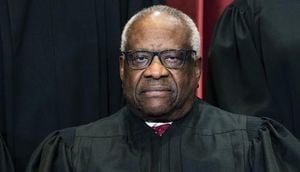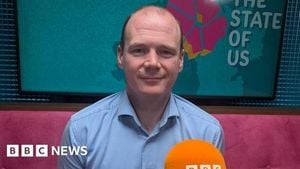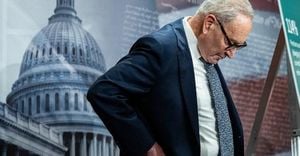On an otherwise ordinary November day in 2024, the quiet streets of West Orange, New Jersey, became the stage for a confrontation that would reverberate far beyond the local community. Outside Congregation Ohr Torah, a synagogue hosting a real estate fair promoting homes in Israel and Israeli settlements in the occupied West Bank, pro-Palestinian demonstrators gathered to express their opposition. What began as a protest quickly escalated, culminating in physical altercations, blaring vuvuzelas, and a national legal battle that would test the boundaries of a law born out of a very different era.
Fast forward to September 29, 2025, and the U.S. Justice Department, under the Trump administration, filed a civil rights lawsuit against two pro-Palestinian advocacy groups—American Muslims for Palestine-New Jersey and the Party for Socialism and Liberation-New Jersey—along with several individuals. According to the Boston Herald, this lawsuit marks the first time the Freedom of Access to Clinic Entrances Act (FACE Act), a statute historically wielded to protect abortion clinics and their patients, has been invoked against protesters outside a house of worship.
Attorney General Pamela Bondi, speaking at a news conference, declared, “No American should be harassed, targeted, or discriminated against for peacefully practicing their religion.” She emphasized the Justice Department’s commitment to defending the rights of Jewish Americans—and all Americans of faith—against those who threaten their right to worship. The civil lawsuit alleges that the protesters did more than voice their dissent; it claims they physically assaulted worshippers and wielded plastic horns, or vuvuzelas, as disruptive weapons, creating an environment of intimidation and chaos.
The event itself was already fraught with tension. The real estate fair at Ohr Torah, promoting property in the West Bank—territory widely regarded as occupied and its settlements illegal under international law—was certain to draw strong reactions, especially amid the ongoing conflict in Gaza. According to reporting by The Guardian, similar events in the U.S. have sparked protests in the wake of renewed hostilities in the Middle East. But the West Orange demonstration turned violent: a pro-Israel counterprotester pepper-sprayed a pro-Palestinian demonstrator, while another counterprotester struck the same person with a flashlight. Local prosecutors charged the two counterprotesters with aggravated assault and related offenses, though both deny the accusations.
Despite this, the Justice Department’s lawsuit focuses exclusively on the actions of the pro-Palestinian demonstrators. The suit contends that the activists not only assaulted at least one pro-Israel protester but also “used vuvuzelas as weapons,” arguing that the horns are “reasonably known to lead to permanent noise-induced hearing loss.” The complaint further alleges that the demonstrators disrupted a memorial service and a Torah lecture taking place at the synagogue, interfering with the attendees’ civil rights to freely exercise their religion.
Harmeet K. Dhillon, Assistant Attorney General in the Civil Rights Division, addressed the unusual application of the FACE Act in a press conference, stating, “These violent protesters meant their actions for evil, but we will use this case to bring forth good: the protection of all Americans’ religious liberty.” Dhillon confirmed that the federal government had never before used the FACE Act to shield houses of worship, noting its historical use to protect reproductive health clinics since its passage in 1994 after a wave of anti-abortion violence.
The penalties sought by the Trump administration are steep. The lawsuit requests fines of more than $30,000 for the first violation of the FACE Act and approximately $50,000 for each subsequent violation. The named groups and individuals have not commented publicly on the lawsuit, and attempts to reach them for a response have been unsuccessful, according to both AP and The Guardian.
The FACE Act, originally signed into law by President Bill Clinton, was a response to escalating violence against abortion providers, including the murder of Dr. David Gunn in 1993. The law prohibits the use of force, threats, or physical obstruction to interfere with people accessing reproductive health centers or houses of worship. Over the years, it has become a flashpoint in the ongoing battle over abortion rights, with anti-abortion advocates and many Republicans calling for its repeal. Under the Trump administration, the Justice Department has dramatically curtailed its use against abortion clinic protesters, describing such prosecutions as the “weaponization” of law enforcement. President Trump has even pardoned several anti-abortion activists convicted under the FACE Act, including participants in the 2020 blockade of a Washington clinic.
For legal scholars, the administration’s pivot to using the FACE Act in defense of religious institutions—while easing enforcement for abortion clinics—raises questions about consistency and intent. Mary Ziegler, a law professor at the University of California, Davis, who specializes in the legal history of reproduction, told The Guardian, “It probably feels like a slap in the face to people who support reproductive rights. The administration has said it’s open season when it comes to the Face Act and reproductive health clinics – but is being pretty aggressive in enforcing it when it comes to places of worship.”
Ziegler suggests that the move may also be an attempt by the Trump administration to assert federal authority in blue states like New Jersey, where local prosecutors may be more sympathetic to certain protest movements. “If you’re the Trump administration and you want to shut down pro-Palestinian protests altogether, reaching for the FACE Act makes sense,” she explained. “The reason the FACE Act was put into place is because people were worried that clinic blockades were dangerous and were leading to violence – and, more importantly, because other criminal laws weren’t getting the job done. So the Trump administration is looking to a federal law with steeper penalties probably for a similar reason.”
The lawsuit’s focus on pro-Palestinian demonstrators, to the exclusion of the pro-Israel counterprotesters who were also charged with assault, has drawn criticism from civil rights advocates and raised concerns about selective enforcement. However, the Essex County Prosecutor’s Office has declined to comment on the pending local prosecutions, leaving the fate of those cases uncertain.
As the legal battle unfolds, the case stands as a striking example of how laws forged in one era can be repurposed in another, sometimes in ways their original drafters never envisioned. The outcome could have far-reaching implications—not just for the parties involved, but for the future of protest, religious freedom, and the ongoing debate over the boundaries of federal civil rights protections.
For now, the streets of West Orange are quiet once again, but the legal and political ripples from that November day continue to spread, challenging Americans to consider whose rights are being protected—and at what cost—when the law is wielded in new and unexpected ways.




